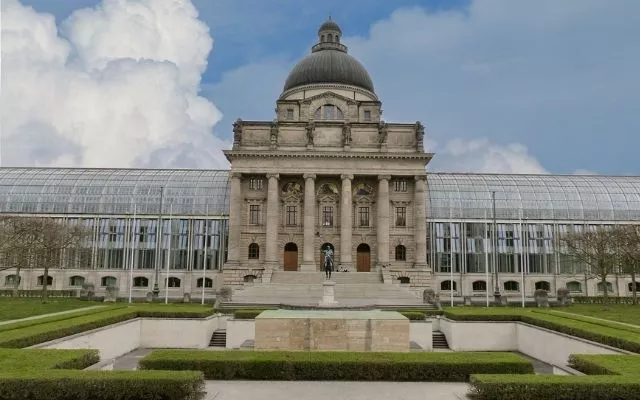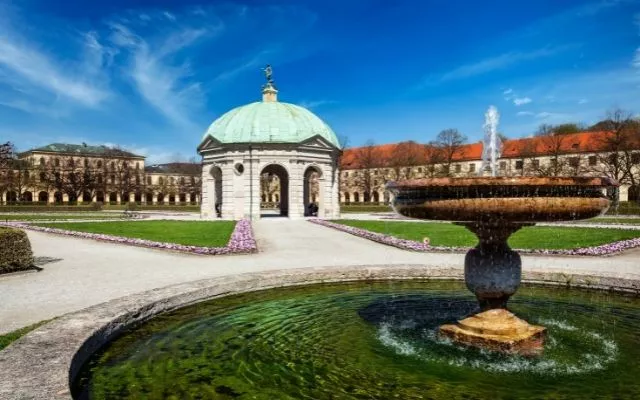Completed as a project by Elector Maximilian I in 1617, the Munich Hofgarten is a green retreat and public garden space that all residents and visitors to Munich can enjoy.
In its earliest form, the Hofgarten was only accessible to the highest echelons of Bavarian Rulers, and it wasn’t until 1780 that then Elector Karl Theodor made the necessary legal changes to ensure the gardens could be enjoyed by the public.
Built according to the Italian Baroque Renaissance style, the gardens have been redesigned many times over the years. After their destruction in World War II, they have now, once again, been returned to their former glory. The Hopfgarten has a layout that currently adheres to its original design which has been copied from antique plans and paintings.
Hofgarten History and Design
Built as an extension to the Royal Palace of Bavaria, Hopfgarten was designed and constructed between 1613 and 1617. The Palace and gardens were owned by the powerful and long-ruling Wittelsbach family who reigned over Bavaria for the better part of a Millenium from 1180 up until 1918.
The center focus of the gardens is the wonderfully picturesque Pavillion constructed in homage to the Goddess Diana. Known as the Diana Temple (Dianatempel), this twelve-sided central gazebo features 8 open and four closed-off arches.
Paths lead out from each of the eight open archways and the solid archways hide four trickling shell fountains in the interior of the structure. Atop the Diana Temple proudly sits a bronze Bavaria Statue that symbolises the riches of the State of Bavaria.

What to See and Do in Hofgarten
To the east side of Hopfgarten stands the buildings housing the Bavarian State Chancellery (Bayerische Staatskanzlei) where all the administrative decisions for the State of Bavaria are made. This is a serious piece of Munich Architecture and with buildings that comprise around 8,800 m² the Bavarian State Chancellery is vast, to say the least.
Directly in front of the Bayerische Staatskanzlei stands the Kriegerdenkmal which is a war memorial dedicated to those who lost their lives in action in World War I. Beneath the Kriegerdenkmal you’ll find a crypt containing the statue of a fallen soldier.
On the western side of the Hofgarten, you’ll find the Hofgartentor – Court Garden Gate. This leads you out onto Odeonsplatz towards the imposing Theatine Church (Theatinerkirche), and the very famous and well photographed Bavarian Army Monument of the Feldherrnhalle.
To the south of the Hofgarten stands the Munich Residenz which was the former palace residence for the House of Wittelsbach and is now one of Munich’s most impressive museums.
The north side of the Hofgarten is bordered by a row of red-tiled buildings behind which is another of Munich’s Inner City Green Spaces featuring the enchanting sculptures of the Finanzgarten.
With various other fountains and memorials dotted about the Hofgarten and plenty of bench seating, it’s very easy to whittle away time here soaking in the history and imagining this inner-city space as it must’ve once been the residents of Munich. Spring and summer sees the gardens resplendent in both green and colourful flowery glory where this almost totally enclosed garden feels most warm and inviting.
Garden Games and Music in The Hofgarten
There are a number of gravel paths within the borders of the Hopfgarten and when good weather strikes, so to do the cities Boule aficionados make for the gardens to engage in impromptu and sometimes haphazard and boisterous competition. Once a year there is actually a well-recognised Boules Tournament held at the Hofgarten with players traveling from all over the world to attend.
The Dianatempel is said to have remarkable acoustics and is likely why you’ll often hear music resonating from within, as budding and professional musicians alike often utilise the small internal space to entertain the public with free musical recitals.
Food and Drink By The Hofgarten
Café Tombosi located on Odeonsplatz also had tables on Hofgarten was once the oldest surviving Cafe in Munich until it closed after more than 200 years of operation back in 2016. The new establishment here although bearing the same (or very similar) name – Tambosi – is a much more upmarket affair. This is definitely a great location to eat and drink, no doubt about it, but you certainly wouldn’t come here for the service which is lackluster to say the least.
The new Tambosi (Tambosi im Hofgarten in München) also operates the small Beergarden in the Hofgarten, and provides a takeawy coffee service as well. Beer is a pretty hard commodity to get wrong but you should certainly be your own judge as to the quality of the coffee served here.
There is also a Starbucks located on Hopfgarten, as well as a Cocktail Bar (that’s open all day Monday to Friday), Casino, and within 0.1 miles of Hofgarten and Odeonsplatz, you’ll find literally dozens of eateries offering all sorts of gastronomical thirst quenching delights.
Hofgarten Munich Map and Location
Hofgarten is an easy 10-minute walk from Marienplatz and the main shopping street of Munich (Kaufingerstraße). The nearby Odeonsplatz U-Bahn Station is serviced by the U3, U4, U5, and U6 lines so the gardens are extremely accessible. Busses and trams pass by the area regularly also. Click here for a Munich Underground (U-Bahn) Map
Hofgarten: Munich’s Most Central Garden
Famous modernist and literary TS Elliot makes mention of the Munich Hofgarten in one of his most well-known pieces of prose from 1922 entitled “The Waste Land”. The poem was written about the symbolism of an empty and unfulfilled noble existence and the death of “Old Europe”.
“Summer surprised us, coming over the Starnbergersee With a shower of rain; we stopped in the colonnade, And went on in sunlight, into the Hofgarten, And drank coffee, and talked for an hour“ – T.S.Elliot, The Waste Land
The aristocracy and the celebrities of the early 20th century were enjoying Hofgarten as a place to take refuge from the surrounding city just as their forefathers did, and just as the regular folk of Munich do to this very day.
Surrounded by history everywhere you look, Munich’s Hofgarten is certainly worth a visit, and with so many other amazing pieces of architecture, museums, places of interest, and more in the surrounding area, it is very easy to spend an entire day in this area of Munich alone.
One of Munichs most well recognised “meeting places”, why not come and see the Munich Hofgarten for yourself and let us know via our contact us page what part of this fantastic garden resonated most on your visit.

